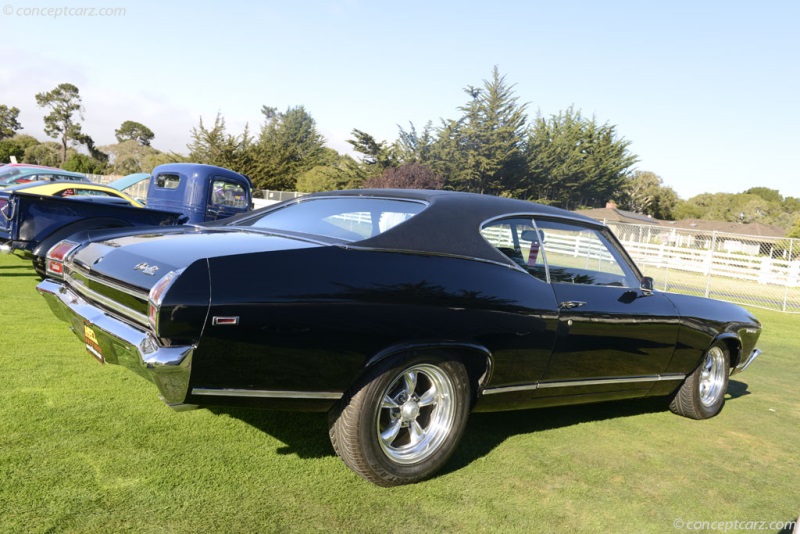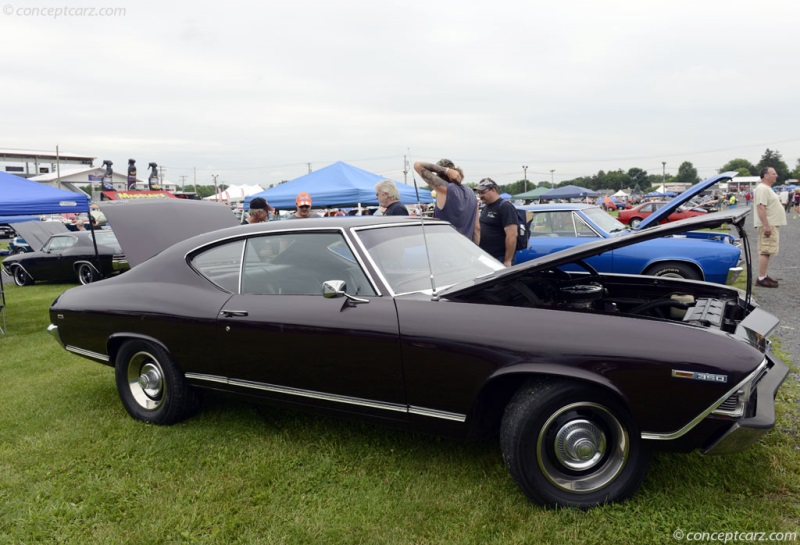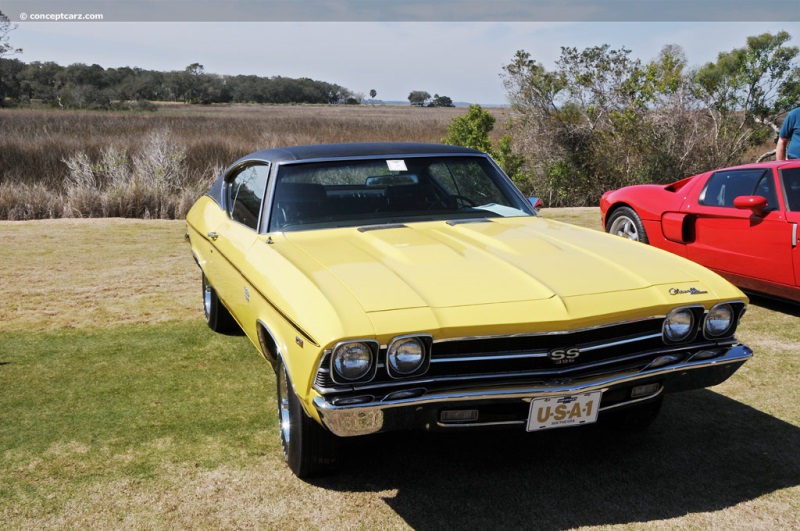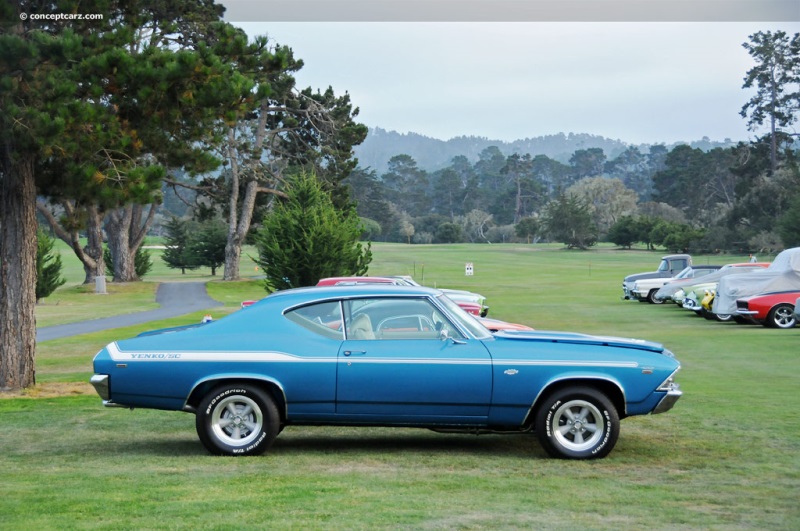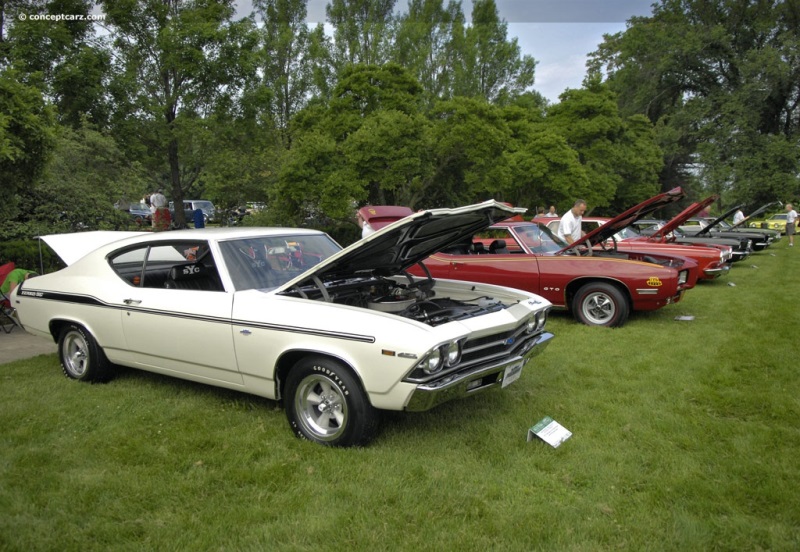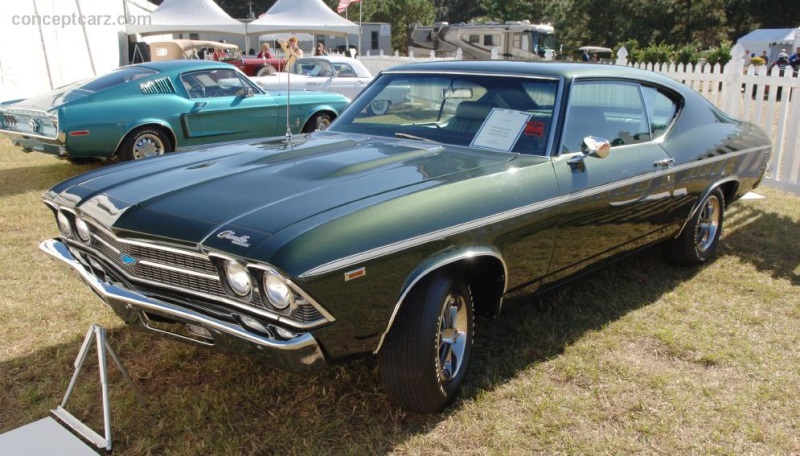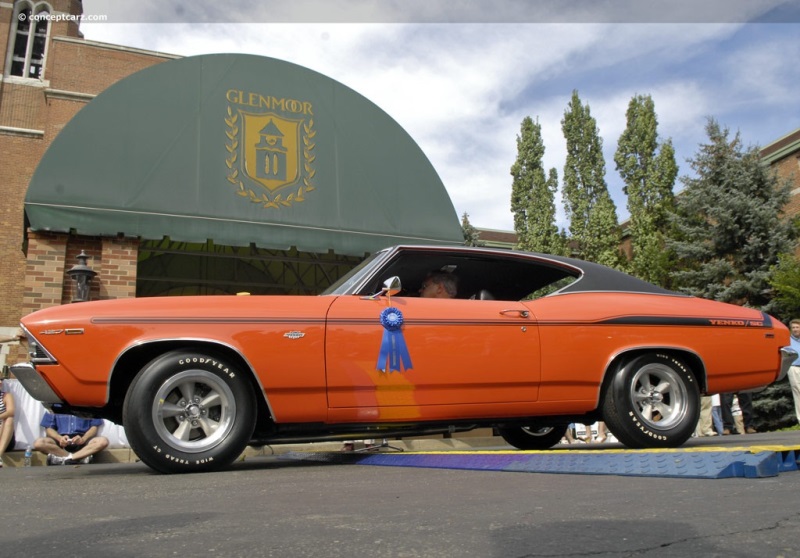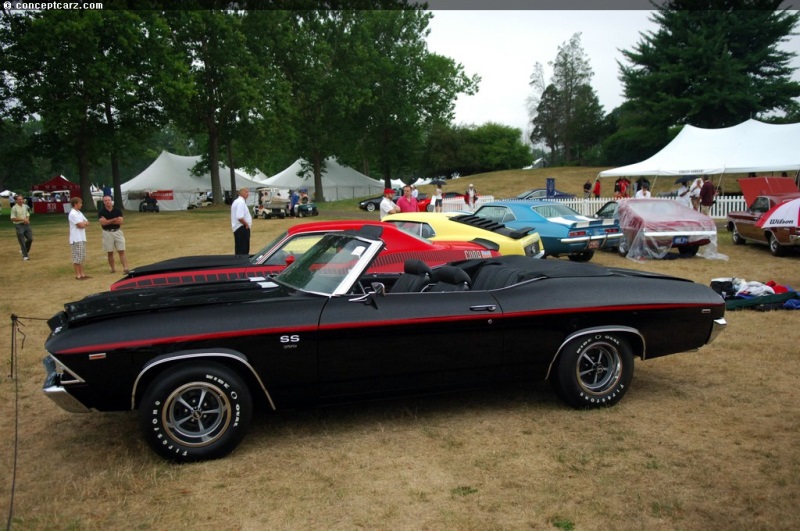Nineteen fifty-five was a Renaissance year for Chevrolet and the start of its assault on the growing youth market. The all-new vehicles wore sharp styling and were powered by a new 265 cubic-inch V8 engine under the hood as optional power. Model year production soared to over 1.7 million, a record for any automaker. An extensive facelift followed a year later along with some potent new power options. The 1957 Chevrolet model became an instant 'Classic' as it was regarded as a baby Cadillac and the Bel Air Sport Coupe, convertible and two-door Nomad station quickly gained a cult following.
1957 was the year Chevrolet bored out the small-block V-8 to 283 cubic inches and made available the most prestigious of options, the Ramjet Fuel injection. Chevy claimed one horsepower per cubic inch.
The mid-1960s were the genesis of the muscle car craze and the entire Detroit market worked aggressively to build cars that could house the larger and more powerful engines. When introduced in 1963, its 327 cubic-inch V8 engine producing 300 horsepower was at a disadvantage to the 389 CID V8 installed in the Pontiac GTO, but internal GM rules, at least for a while, attempted to keep Chevrolet's brand identity in its place.
The Chevrolet Chevelle was introduced on September 26th of 1963 as a mid-sized member of the Chevrolet fleet. It was essentially a smaller version of the Bel Air, Biscayne, and Impala that were still strong sellers but did not fit in with the new trend of smaller cars. It was built atop a new A-frame platform and could be ordered initially as a two or four-door. The 300 Series was the base model while the Malibu SS was the top-of-the-line model, and Chevrolet built over 76,800 examples of the Chevelle SS during the 1964 model year. Engine options included the older 283 two-barrel and variations of the 327 with horsepower ranging from 195 through 300 bhp. Although this initial success was promising, Chevrolet still needed to prove that they were still capable of competing outside of the Corvette. In grand fashion, Chevrolet not only displayed their performance capabilities in 1965, but it also posted a number of records in the process.
The Z-16 performance package was unleashed in a limited number for 1965, powered by a 396 cubic-inch V8 with 375 hp, a highly modified suspension, power-assisted steering, and sway bars in the front and rear. The gear ratio behind the Muncie 4-speed transmission was raised from 3.31 to 4.56. The 283 and 327 cubic-inch engines were still available, and the base engine still offered 195 horsepower while the top-of-the-line L69 327 had 350 horsepower.
During the late 1960s, Chevrolet's market share for products declined, partly due to Ralph Nader's attack on the Corvair. Auto sales in general declined but had a particularly severe effect on Chevrolet, and the Corvair was dropped in 1969.
Although market share declined, Chevrolet began catching up with the market, as well as its sister brands, in the horsepower race. By 1966, no small-block Chevelle remained available. Rather, the 396 became the standard engine with the horsepower outputs offered between 325 and 375 bhp. The higher the horsepower, the greater the number of other components of the vehicle that required upgrading. As a result, all Chevelles were outfitted with stiffer springs and shocks to counter handling problems. To showcase the 396 cubic-inch engine lurking underneath the hood, the SS name was switched to SS396. A more aggressive appearance was the result of a new bumper, dual hood scoops, and a new roofline. Front disc brakes became available in 1967 and a three-speed automatic joined the list of transmission options.
The Chevelle SS was redesigned in 1968, with the rear of the car shortened while the front was stretched for a fastback appearance.
1969 Chevrolet Chevelle
Chevrolet completely redesigned its full-size models for 1969 and while the wheelbase remained unchanged, the overall length increased by an inch. Only minor styling changes occurred with the 1969 Chevelle to distinguish it from the all-new 1968 model. The restyling of the front grille included a horizontal grill bar in the center with the bumpers incorporating an opening in which the turn signals were located. The rear taillights were larger and were angled inward. The four-door body styles continued to rest on a 116-inch wheelbase platform while the two-door body styles used a 112-inch platform.
Chevelle trim packages for 1969 included the Chevelle 300 Deluxe and the Chevelle Malibu. The SS-396 (Z25) was still available as an option package.
The Chevelle 300 Deluxe body styles included a sedan priced at $2,490, a coupe at $2,460, a hardtop sport coupe at $2,520, the six-passenger Nomad at $2,670, and the Nomad with the 'Dual-Action tailgate, priced at $2,710. The Greenbrier station wagon listed for $2,780, the nine-passenger version at $2,820, and the version with the 'Dual-Action' tailgate (only available with the eight-cylinder engine), listed for $3,025. The standard engine was the 230 cubic-inch inline-6 with overhead valves, seven main bearings, hydraulic valve lifters, a Rochester one-barrel carburetor, and delivering 140 horsepower at 4,400 RPM. The standard eight-cylinder option was the 306.6 (307) cubic-inch V8 with overhead valves, five main bearings, a Rochester two-barrel carburetor, hydraulic valve lifters, and delivering 200 horsepower at 4,600 RPM.
Standard equipment installed on the Chevelle 300 Deluxe included 7.35 x 14 four-ply rated Blackwall tires, dual headlights, thin rocker panel moldings, bright metal windshield and rear window framing, bright metal roof drip moldings, front armrests, a heater and defroster, and series identification badging. The station wagons had all-vinyl interior trim, dual-speed electric wipers and windshield washers.
Chevrolet built approximately 42,000 examples of the Chevelle 300 Deluxe in 1969, with around 21,000 powered by six-cylinder engines and the other half with eight-cylinder engines. Around 45,900 examples of the station wagons were also built with 7,400 equipped with six-cylinder engines.
The intermediate-priced Chevelle was the 'Chevelle Malibu' and included all the equipment found on the 'base' model plus a Deluxe steering wheel, Hide-Away two-speed wipers, carpeting, glove box light, and window molding. Body styles included a sedan priced at $2,565, a convertible at $2,800, a hardtop sport coupe at $2,600, and the hardtop sedan at $2,670. The estate wagon was only available with eight-cylinder power and the six-passenger version was $3,150 while the nine-passenger version at $3,265.
Chevrolet built approximately 367,100 examples of the Malibu, with around 25,000 of those equipped with six-cylinder engines. The 45,900 examples of the station wagon, listed above, included the Malibu Estate Wagon production. Approximately 8,927 examples were Malibu or SS-396 convertibles.
To highlight the standard big-block and the SS package, 'SS 396' became an option package for the Chevelles for 1969. The RPO Z25 optional Super Sport package was now an option on any Chevelle V8 hardtop or convertible. Along with specific badging on the grille, front fenders and the blacked-out taillamp panel, the SS package also featured a domed hood and power front disc brakes.
The Chevelle's front line of defense for the muscle car wars was the RPO L78 option, and it is believed that most dealers were unaware of this option code. Finding an L78 example on the showroom floor was a very rare occurrence. The process of obtaining the RPO L78 included getting ahold of a Special Product Order form, filling in the proper information, and then have the dealer place the order for you. It was an approximately six to eight weeks wait until the transporter would show up with your special L78 Chevelle.
Part of the L78 SS 396 package was the F41 heavy-duty suspension which offered firm springs, a large stabilizer bar and stiffer shocks on the front, backed with a four-link coil-spring rear layout, also with firm shocks. The rear lower control arms were boxed by a plate welded across the sides for reinforcement. A rear stabilizer bar was bolted to the inner sides of the control arms. The upper arms were braced to handle the torque of the L78.
The 396 cubic-inch L78 V8 delivered 375 horsepower and only took a back seat to the L89 which had aluminum heads but was rated at the same horsepower. Although the L78 was an expensive option at $252.80, it was much more affordable than the L89 option at $647.75.
Approximately 323 examples of the Copo L72 Chevelle were built in 1969, equipped with the 427 cubic-inch V8 with 425 horsepower, the largest displacement engine available since the Chevelle's introduction. Of 323 'Big Block' COPO Chevelles built 99 of them became Yenko SYC's or Yenko Super Cars. An estimated 17 to 22 of the L72 Chevelles were delivered in Canada.
The RPO L72 solid-lifter big block engine was made famous in the 1966 Corvette. In 1969 it was offered as a COPO (Central Office Production Order) option in the Chevelle and Camaro. Don Yenko once said that they were 'a beast, almost lethal.' Yenko was not alone in this belief, and the insurance companies stepped in and virtually ended production as they did not want to insure them.
Yenko Chevelle
Don Yenko was a Chevrolet dealer in Canonsburg, Pennsylvania, and he established a reputation for being a fast and very determined driver at the wheel of Corvettes in the early 1960s. Yenko won many races and two National Championships with his Corvettes, but by the end of 1965, his car was out-classed by the lighter, Ford-powered products of Shelby American. He pleaded with General Motors to build something more competitive, but GM had officially pulled out of racing by then, so GM declined his requests. Instead, Yenko began preparing his own performance-based Chevrolets.
The Yenko Super Camaro was created by installing the 427 cubic-inch, 425 horsepower engine under the hood. Along with the tuned mechanical components, these special cars all had the special Yenko hood scoop and Yenko emblems, along with 427 and custom Yenko identifiers and badging. Most of the early Yenko Camaros went to Chicago where they were distributed by Span Inc.
By the close of 1967, demand for the 427 Camaros outpaced Yenko's ability to provide them to the market, so he approached Chevrolet about getting factory-equipped 427 Camaros. Although hesitant at first, the Special Projects Division was eager to explore its potential. At first, they agreed to supply the factory 427's to Yenko as long as it remained clandestine, and until recently, it was believed that all 68 of the 1968 Yenko Camaros were dealer installed. The COPO program allowed Yenko to eliminate arduous and expensive engine changes.
The COPO 9562 High Performance 427 package, like the COPO Camaros, used the L72 cast-iron big-block with 4-bolt main bearing caps, forged steel crank and rods, forged aluminum pistons, 11.0:1 compression, a solid-lifter cam, aluminum intake and 800 CFM Holley 4-barrel. The COPO Chevelle also used the special reinforced 4.10:1 12-bolt Positraction rear end, and could be ordered with either a 400 Turbo automatic, an M22 'Rock Crusher' 4-speed, or the Muncie M21 close-ratio unit. F41 heavy-duty suspension and power front disc brakes were also required.
Chevrolet built 86,307 Chevelles SS-396 models in 1969, and of that number, 323 were COPO cars, and of those, 99 were sent to Yenko to be converted into a Yenko SC Chevelle at his Pennsylvania, dealership, where they were emblazoned with the same contrasting 3M vinyl graphics as the Yenko Super Camaro
The COPO Chevelle, like the Camaro counterpart, was aimed at NHRA Super Stock SS/D competition.
by Daniel Vaughan | Apr 2021
1957 was the year Chevrolet bored out the small-block V-8 to 283 cubic inches and made available the most prestigious of options, the Ramjet Fuel injection. Chevy claimed one horsepower per cubic inch.
The mid-1960s were the genesis of the muscle car craze and the entire Detroit market worked aggressively to build cars that could house the larger and more powerful engines. When introduced in 1963, its 327 cubic-inch V8 engine producing 300 horsepower was at a disadvantage to the 389 CID V8 installed in the Pontiac GTO, but internal GM rules, at least for a while, attempted to keep Chevrolet's brand identity in its place.
The Chevrolet Chevelle was introduced on September 26th of 1963 as a mid-sized member of the Chevrolet fleet. It was essentially a smaller version of the Bel Air, Biscayne, and Impala that were still strong sellers but did not fit in with the new trend of smaller cars. It was built atop a new A-frame platform and could be ordered initially as a two or four-door. The 300 Series was the base model while the Malibu SS was the top-of-the-line model, and Chevrolet built over 76,800 examples of the Chevelle SS during the 1964 model year. Engine options included the older 283 two-barrel and variations of the 327 with horsepower ranging from 195 through 300 bhp. Although this initial success was promising, Chevrolet still needed to prove that they were still capable of competing outside of the Corvette. In grand fashion, Chevrolet not only displayed their performance capabilities in 1965, but it also posted a number of records in the process.
The Z-16 performance package was unleashed in a limited number for 1965, powered by a 396 cubic-inch V8 with 375 hp, a highly modified suspension, power-assisted steering, and sway bars in the front and rear. The gear ratio behind the Muncie 4-speed transmission was raised from 3.31 to 4.56. The 283 and 327 cubic-inch engines were still available, and the base engine still offered 195 horsepower while the top-of-the-line L69 327 had 350 horsepower.
During the late 1960s, Chevrolet's market share for products declined, partly due to Ralph Nader's attack on the Corvair. Auto sales in general declined but had a particularly severe effect on Chevrolet, and the Corvair was dropped in 1969.
Although market share declined, Chevrolet began catching up with the market, as well as its sister brands, in the horsepower race. By 1966, no small-block Chevelle remained available. Rather, the 396 became the standard engine with the horsepower outputs offered between 325 and 375 bhp. The higher the horsepower, the greater the number of other components of the vehicle that required upgrading. As a result, all Chevelles were outfitted with stiffer springs and shocks to counter handling problems. To showcase the 396 cubic-inch engine lurking underneath the hood, the SS name was switched to SS396. A more aggressive appearance was the result of a new bumper, dual hood scoops, and a new roofline. Front disc brakes became available in 1967 and a three-speed automatic joined the list of transmission options.
The Chevelle SS was redesigned in 1968, with the rear of the car shortened while the front was stretched for a fastback appearance.
1969 Chevrolet Chevelle
Chevrolet completely redesigned its full-size models for 1969 and while the wheelbase remained unchanged, the overall length increased by an inch. Only minor styling changes occurred with the 1969 Chevelle to distinguish it from the all-new 1968 model. The restyling of the front grille included a horizontal grill bar in the center with the bumpers incorporating an opening in which the turn signals were located. The rear taillights were larger and were angled inward. The four-door body styles continued to rest on a 116-inch wheelbase platform while the two-door body styles used a 112-inch platform.
Chevelle trim packages for 1969 included the Chevelle 300 Deluxe and the Chevelle Malibu. The SS-396 (Z25) was still available as an option package.
The Chevelle 300 Deluxe body styles included a sedan priced at $2,490, a coupe at $2,460, a hardtop sport coupe at $2,520, the six-passenger Nomad at $2,670, and the Nomad with the 'Dual-Action tailgate, priced at $2,710. The Greenbrier station wagon listed for $2,780, the nine-passenger version at $2,820, and the version with the 'Dual-Action' tailgate (only available with the eight-cylinder engine), listed for $3,025. The standard engine was the 230 cubic-inch inline-6 with overhead valves, seven main bearings, hydraulic valve lifters, a Rochester one-barrel carburetor, and delivering 140 horsepower at 4,400 RPM. The standard eight-cylinder option was the 306.6 (307) cubic-inch V8 with overhead valves, five main bearings, a Rochester two-barrel carburetor, hydraulic valve lifters, and delivering 200 horsepower at 4,600 RPM.
Standard equipment installed on the Chevelle 300 Deluxe included 7.35 x 14 four-ply rated Blackwall tires, dual headlights, thin rocker panel moldings, bright metal windshield and rear window framing, bright metal roof drip moldings, front armrests, a heater and defroster, and series identification badging. The station wagons had all-vinyl interior trim, dual-speed electric wipers and windshield washers.
Chevrolet built approximately 42,000 examples of the Chevelle 300 Deluxe in 1969, with around 21,000 powered by six-cylinder engines and the other half with eight-cylinder engines. Around 45,900 examples of the station wagons were also built with 7,400 equipped with six-cylinder engines.
The intermediate-priced Chevelle was the 'Chevelle Malibu' and included all the equipment found on the 'base' model plus a Deluxe steering wheel, Hide-Away two-speed wipers, carpeting, glove box light, and window molding. Body styles included a sedan priced at $2,565, a convertible at $2,800, a hardtop sport coupe at $2,600, and the hardtop sedan at $2,670. The estate wagon was only available with eight-cylinder power and the six-passenger version was $3,150 while the nine-passenger version at $3,265.
Chevrolet built approximately 367,100 examples of the Malibu, with around 25,000 of those equipped with six-cylinder engines. The 45,900 examples of the station wagon, listed above, included the Malibu Estate Wagon production. Approximately 8,927 examples were Malibu or SS-396 convertibles.
To highlight the standard big-block and the SS package, 'SS 396' became an option package for the Chevelles for 1969. The RPO Z25 optional Super Sport package was now an option on any Chevelle V8 hardtop or convertible. Along with specific badging on the grille, front fenders and the blacked-out taillamp panel, the SS package also featured a domed hood and power front disc brakes.
The Chevelle's front line of defense for the muscle car wars was the RPO L78 option, and it is believed that most dealers were unaware of this option code. Finding an L78 example on the showroom floor was a very rare occurrence. The process of obtaining the RPO L78 included getting ahold of a Special Product Order form, filling in the proper information, and then have the dealer place the order for you. It was an approximately six to eight weeks wait until the transporter would show up with your special L78 Chevelle.
Part of the L78 SS 396 package was the F41 heavy-duty suspension which offered firm springs, a large stabilizer bar and stiffer shocks on the front, backed with a four-link coil-spring rear layout, also with firm shocks. The rear lower control arms were boxed by a plate welded across the sides for reinforcement. A rear stabilizer bar was bolted to the inner sides of the control arms. The upper arms were braced to handle the torque of the L78.
The 396 cubic-inch L78 V8 delivered 375 horsepower and only took a back seat to the L89 which had aluminum heads but was rated at the same horsepower. Although the L78 was an expensive option at $252.80, it was much more affordable than the L89 option at $647.75.
Approximately 323 examples of the Copo L72 Chevelle were built in 1969, equipped with the 427 cubic-inch V8 with 425 horsepower, the largest displacement engine available since the Chevelle's introduction. Of 323 'Big Block' COPO Chevelles built 99 of them became Yenko SYC's or Yenko Super Cars. An estimated 17 to 22 of the L72 Chevelles were delivered in Canada.
The RPO L72 solid-lifter big block engine was made famous in the 1966 Corvette. In 1969 it was offered as a COPO (Central Office Production Order) option in the Chevelle and Camaro. Don Yenko once said that they were 'a beast, almost lethal.' Yenko was not alone in this belief, and the insurance companies stepped in and virtually ended production as they did not want to insure them.
Yenko Chevelle
Don Yenko was a Chevrolet dealer in Canonsburg, Pennsylvania, and he established a reputation for being a fast and very determined driver at the wheel of Corvettes in the early 1960s. Yenko won many races and two National Championships with his Corvettes, but by the end of 1965, his car was out-classed by the lighter, Ford-powered products of Shelby American. He pleaded with General Motors to build something more competitive, but GM had officially pulled out of racing by then, so GM declined his requests. Instead, Yenko began preparing his own performance-based Chevrolets.
The Yenko Super Camaro was created by installing the 427 cubic-inch, 425 horsepower engine under the hood. Along with the tuned mechanical components, these special cars all had the special Yenko hood scoop and Yenko emblems, along with 427 and custom Yenko identifiers and badging. Most of the early Yenko Camaros went to Chicago where they were distributed by Span Inc.
By the close of 1967, demand for the 427 Camaros outpaced Yenko's ability to provide them to the market, so he approached Chevrolet about getting factory-equipped 427 Camaros. Although hesitant at first, the Special Projects Division was eager to explore its potential. At first, they agreed to supply the factory 427's to Yenko as long as it remained clandestine, and until recently, it was believed that all 68 of the 1968 Yenko Camaros were dealer installed. The COPO program allowed Yenko to eliminate arduous and expensive engine changes.
The COPO 9562 High Performance 427 package, like the COPO Camaros, used the L72 cast-iron big-block with 4-bolt main bearing caps, forged steel crank and rods, forged aluminum pistons, 11.0:1 compression, a solid-lifter cam, aluminum intake and 800 CFM Holley 4-barrel. The COPO Chevelle also used the special reinforced 4.10:1 12-bolt Positraction rear end, and could be ordered with either a 400 Turbo automatic, an M22 'Rock Crusher' 4-speed, or the Muncie M21 close-ratio unit. F41 heavy-duty suspension and power front disc brakes were also required.
Chevrolet built 86,307 Chevelles SS-396 models in 1969, and of that number, 323 were COPO cars, and of those, 99 were sent to Yenko to be converted into a Yenko SC Chevelle at his Pennsylvania, dealership, where they were emblazoned with the same contrasting 3M vinyl graphics as the Yenko Super Camaro
The COPO Chevelle, like the Camaro counterpart, was aimed at NHRA Super Stock SS/D competition.
by Daniel Vaughan | Apr 2021
Related Reading : Chevrolet Chevelle History
The Chevelle was introduced on September 26, 1963, as a mid-sized vehicle for the Chevrolet fleet. It was basically a smaller version of the Impala. Muscle cars were associated with small vehicles with low weight and very few amenities but large amounts of horsepower from massive engines. The entire Detroit market had been stricken by creating faster, more vehicles. The Chevelle flirted with this....
Continue Reading >>
Continue Reading >>
Related Reading : Chevrolet Chevelle History
One of General Motors most successful vehicles, the Chevelle was a mid-sized car that was introduced in 1964 and was produced until 1977. The Chevelle models ranged from economical little family cars to commanding coupes and stunning convertibles. The Malibu was originally the top trim level in the Chevelle line which eventually replaced the Chevelle name entirely after 1977. Based on the reengineered....
Continue Reading >>
Continue Reading >>
Similarly Sized Vehicles
from 1969
Similarly Priced Vehicles
Chevrolet Monthly Sales Volume
March 2023
398,141
1969 Chevrolet Chevelle Vehicle Profiles
Recent Vehicle Additions
Performance and Specification Comparison
Price Comparison
$2,240 - $2,435
$2,260 - $2,640
$2,380 - $3,195
$2,614 - $2,762
$2,635 - $2,850
$2,685 - $3,065
$2,910 - $3,465
$3,295 - $3,675
$4,425 - $4,765
Chevelle Specification Comparison by Year
Year
Production
Wheelbase
Engine
Prices
422,893
112.00 in.
6 cyl., 230.00 CID., 140.00hp
6 cyl., 250.00 CID., 155.00hp
8 cyl., 307.00 CID., 200.00hp
8 cyl., 327.00 CID., 250.00hp
8 cyl., 327.00 CID., 275.00hp
8 cyl., 396.00 CID., 325.00hp
8 cyl., 327.00 CID., 350.00hp
8 cyl., 395.31 CID., 375.00hp
6 cyl., 250.00 CID., 155.00hp
8 cyl., 307.00 CID., 200.00hp
8 cyl., 327.00 CID., 250.00hp
8 cyl., 327.00 CID., 275.00hp
8 cyl., 396.00 CID., 325.00hp
8 cyl., 327.00 CID., 350.00hp
8 cyl., 395.31 CID., 375.00hp
$2,340 - $3,100
455,000
116.00 in.
6 cyl., 230.00 CID., 140.00hp
6 cyl., 250.00 CID., 155.00hp
8 cyl., 307.00 CID., 200.00hp
8 cyl., 350.00 CID., 250.00hp
8 cyl., 350.00 CID., 255.00hp
8 cyl., 350.00 CID., 300.00hp
8 cyl., 396.00 CID., 325.00hp
8 cyl., 396.00 CID., 350.00hp
8 cyl., 396.00 CID., 375.00hp
8 cyl., 427.00 CID., 425.00hp
6 cyl., 250.00 CID., 155.00hp
8 cyl., 307.00 CID., 200.00hp
8 cyl., 350.00 CID., 250.00hp
8 cyl., 350.00 CID., 255.00hp
8 cyl., 350.00 CID., 300.00hp
8 cyl., 396.00 CID., 325.00hp
8 cyl., 396.00 CID., 350.00hp
8 cyl., 396.00 CID., 375.00hp
8 cyl., 427.00 CID., 425.00hp
$2,485 - $3,270
354,855
112.00 in., 116.00 in.
6 cyl., 250.00 CID., 155.00hp
8 cyl., 307.00 CID., 200.00hp
8 cyl., 350.00 CID., 250.00hp
8 cyl., 400.00 CID., 265.00hp
8 cyl., 350.00 CID., 300.00hp
8 cyl., 400.00 CID., 330.00hp
8 cyl., 454.00 CID., 360.00hp
8 cyl., 402.00 CID., 375.00hp
8 cyl., 307.00 CID., 200.00hp
8 cyl., 350.00 CID., 250.00hp
8 cyl., 400.00 CID., 265.00hp
8 cyl., 350.00 CID., 300.00hp
8 cyl., 400.00 CID., 330.00hp
8 cyl., 454.00 CID., 360.00hp
8 cyl., 402.00 CID., 375.00hp
$2,540 - $3,700
327,159
112.00 in., 115.00 in.
6 cyl., 250.00 CID., 145.00hp
8 cyl., 350.00 CID., 270.00hp
8 cyl., 402.00 CID., 300.00hp
8 cyl., 454.00 CID., 365.00hp
8 cyl., 454.00 CID., 425.00hp
8 cyl., 350.00 CID., 270.00hp
8 cyl., 402.00 CID., 300.00hp
8 cyl., 454.00 CID., 365.00hp
8 cyl., 454.00 CID., 425.00hp
$2,675 - $3,650
49,400
112.00 in., 116.00 in., 125.00 in.
6 cyl., 250.00 CID., 110.00hp
8 cyl., 307.00 CID., 130.00hp
8 cyl., 350.00 CID., 165.00hp
8 cyl., 350.00 CID., 175.00hp
8 cyl., 402.00 CID., 240.00hp
8 cyl., 454.00 CID., 270.00hp
8 cyl., 307.00 CID., 130.00hp
8 cyl., 350.00 CID., 165.00hp
8 cyl., 350.00 CID., 175.00hp
8 cyl., 402.00 CID., 240.00hp
8 cyl., 454.00 CID., 270.00hp
$2,635 - $3,135
Related Automotive News

Bugatti Heritage – A year of records
Classic Bugatti cars achieved record results at auctions in 2020.
image00
Historic Bugatti cars continue to rise in value. Five automotive masterpieces from Molsheim were the five most valuable vehicles sold at auction internationally in 2020....

Mecum Returns To The Fairplex With 600 Collector Cars Feb. 16-17
2018 Bugatti Chiron, 2015 McLaren 650S Spider to Headline Los Angeles 2018 Auction
Walworth, Wis. – Jan. 25, 2018 – Mecum Auctions, the worlds largest collector-car auction company, is set to return to the Fairplex in Pomona, California,...
MOPAR TO CELEBRATE 50TH ANNIVERSARY OF THE ICONIC 426 HEMI IN 2014
Mopar Unveils Logo, Special Product Line and Plans Marketing Events
2014 marks 50th anniversary of the introduction of the Gen II 426 Race HEMI®
Mopar unveils 50th anniversary HEMI logo celebrating the iconic engine
Engine made its legendar...

Raw Power Has a Stamp of Its Own Muscle Cars Roar at Spring Classic Auction
What do you get when you bring the U.S. Postal Service and Dana Mecums Original Spring Classic Auction together at the State Fairgrounds — a Muscle Car Extravaganza!
Since it began 26 years ago, Mecums Spring Classic auction in Indianapolis...

Chevy Performance Rolls with Hot Rod Magazine Power Tour
Weeklong drive kicks off with unprecedented access to GMs Milford Proving Ground
Road trip! Its that time of year again for the annual automotive pilgrimage known as the Hot Rod Magazine Power Tour® and Chevrolet Performance helps get it started...






























